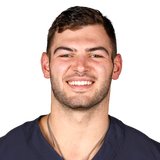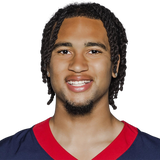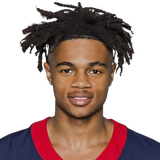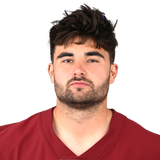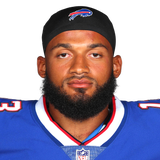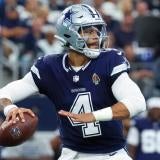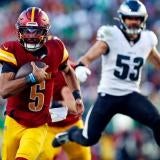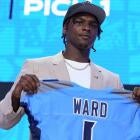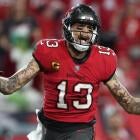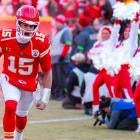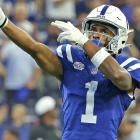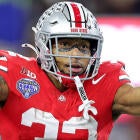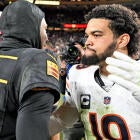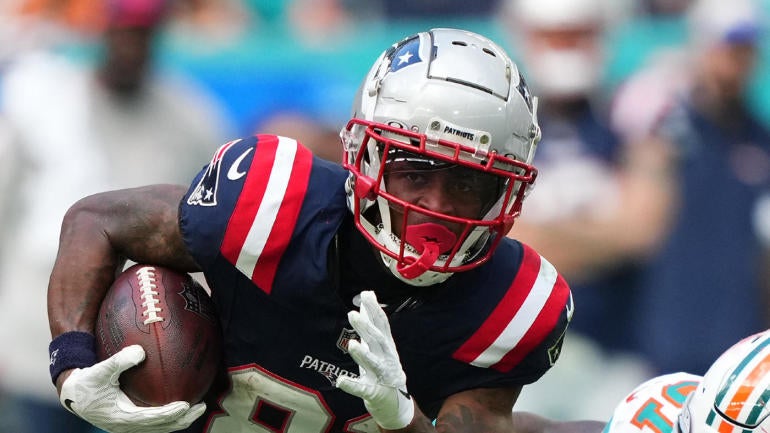
Fantasy Football is all about the matchups. Even though you drafted your team with certain hopes and intentions, your weekly lineup decisions shouldn't be determined by the order you picked your players in. You need to check who your players play and make sure you've got the right guys in -- and the wrong guys out.
It's too early to be absolutely sure on which matchups will be easy and which ones will be tough, but we can take some educated guesses based on healthy personnel, defensive schemes, track records and key details of offenses. The things we know can help us minimize the impact of the things we don't know. This should lead to better decisions being made.
We'll go through every game and highlight the players who aren't obvious starts and sits (because you don't need to be told to start Christian McCaffrey). You should feel more comfortable starting or sitting players based on the information given, and feeling comfortable with your Fantasy lineup before the games start is the best feeling in the world.
It's also important to have a keen eye for matchups dictated by the remaining schedule. I am now updating my projected Strength of Schedule rankings broken down by position available on SportsLine. My objective is to break down how the schedule affects every Fantasy relevant player for the upcoming four weeks, the playoff stretch and the entire season. You'll also be able to find my key takeaways on which players you should buy low, sell high and more trade advice.
Kmet's volume in Chicago has been mostly good and Fantasy production has followed. This could be a game where Chicago has some success running the ball, which in turn could limit Kmet's effectiveness. But if you continue treating him as a 10-to-12-point PPR tight end, he shouldn't disappoint. I'd start him over Kyle Pitts, George Kittle and Trey McBride.
| ||||||||||||||||||
LAST WEEK/FILM: Had two touchdowns by halftime, both on single-coverage routes where Tyson Bagent flicked the ball in Kmet's general direction and the big lug made a play. The first one was a designed bootleg meant to send the defense one way while Kmet ran the other, but Tyrann Mathieu didn't fall for it. He didn't make a good play on the ball, though, and Kmet beat him for it on a contested catch. The second one looked like plenty of the plays Kmet had been running for weeks -- a block first, then into a route -- and Kmet burst past the linebacker he blocked into clear space for an easy open touchdown off play-action. Both plays were reminders of how good the Bears drew up red-zone plays last year. He had two other grabs for 11 yards on the day (both plays helped by Bagent keeping plays alive and looking for open targets) and finished with 23.5 PPR points.
KMET: After a catchless Week 7, Kmet has seen at least eight targets per game in two straight with over 17 PPR points per.
PANTHERS: Have already been one of the league's worst at pass rush pressure rate (28.5% on the season is second-lowest) but will play this game on a short week on the road without top edge Brian Burns, leaving Derrick Brown, Frankie Luvu and Justin Houston as their top pass rush options this week. Luvu has five sacks over 46 pass rush plays this season while Brown and Houston each have one sack and 15 total QB hurries. Their lack of pressure should help the Bears complete passes.
BEARS: Against the Saints, Chargers and Raiders have allowed a pass rush pressure on 31.2% of their snaps. That's 10th-lowest in football. Not bad! Their offensive line should be up to the task of controlling the Panthers pass rush and giving more routes for Kmet without having to block first.
TARGET SHARE: With Bagent, Kmet is second on the team with a 17% target share, but that includes his donut in Week 7; his number is 28.6% in his past two with Bagent. With Fields, Kmet sees a 21.2% target share.
PANTHERS: Have succeeded against tight ends, partially because they give up so much to running backs. Only one tight end -- Sam LaPorta -- has more than nine PPR points against Carolina. Kyle Pitts, T.J. Hockenson and Dalton Schultz all struggled statistically; only Schultz did poorly without his team running the ball well.
Douglas is more of a long-term Fantasy asset, but the Patriots need explosive plays and he can give them a couple on the short routes he separates from defenders on. Indy's zone-heavy defense also helps Douglas as far as finding space to make catches without having to win deep downfield. If you bank on volume, it's possible Douglas lands between 10 and 12 PPR points. I'd start him over the Packers WRs, Michael Thomas and Tyler Boyd.
| ||||||||||||||||||
LAST WEEK: As the Patriots continued to keep Mac Jones' passes short, Douglas ran a season-high 38 routes and authored a 5-55-0 stat line on seven targets, tying for the team lead. He didn't have a high Average Depth of Target (ADOT), just 6.86 yards, but he averaged a best-among-WRs 6.2 Yards After the Catch per reception (YAC/reception). It was his first game with double-digit PPR points.
FILM: I came away impressed with Douglas' speed and agility. He used a hesitation move several times off the snap to get a defensive back off-balance before bursting into his route, then would change direction by cutting on a dime. There were also two receptions Douglas made where he had to adjust to imperfect targets from Jones. About the only drawback was that Douglas is smallish and could struggle with press coverage.
SHORT ROUTES: Douglas also isn't used as a field stretcher -- last week only two of his routes went 15 or more yards. That's not a lot, but considering he ran seven such routes coming into the game, it's not the worst thing in the world for him. Do the math and 9 of 153 routes he's run this year have gone deep.
WHY NOT JUJU? In Week 9, JuJu Smith-Schuster had seven targets and caught six of them for 51 yards. Like Douglas, Smith-Schuster also snared a bunch of short throws. Unlike Douglas, Smith-Schuster lined up nearly exclusively outside and had a 4.86-yard ADOT (Average Depth of Target) on only 19 routes run. He's less likely to make an explosive play than Douglas, even though they each had one last week.
COLTS: Even without premier cornerbacks or a great pass rush, they've done a nice job against receivers. Specifically against receivers running short routes (under 15 Air Yards), the Colts have allowed in their past four games just one score, a 62.2% completion rate and a tiny 2.5 YAC/reception with a top-10 defensive EPA. Two receivers -- Christian Kirk and Rashid Shaheed -- have had more than 13 PPR points in those games.
The natural reaction to seeing Henry have a big game is to start him in hopes he can do it again. He did exactly that in Weeks 1 and 2 this season. But the Colts matchup is tough on him, and easy on his teammates. I'd be mildly surprised if he had more than five targets and especially surprised if he had another game with 13-plus PPR points. I'd rather start Trey McBride, David Njoku and Cade Otton.
| ||||||||||||||||||
LAST WEEK: Scored on a route combo that Mac Jones read perfectly and threw with anticipation to Henry -- he didn't even have his head turned around before Jones threw the ball! That's good synergy, but it's really the only standout play by Henry, who served as a short-area target with better-than-average speed for a tight end. Henry's touchdown also came on a backup linebacker, so the matchup at the time was also right.
HENRY: Had five or fewer targets in six games prior to last week, and three or fewer in four of them. Henry went touchdownless in all of those games. Washington's track record of allowing a touchdown to a tight end in three of their four games going into Week 9 may have made Henry more of a target than normal, as might have Kendrick Bourne's season-ending injury.
COLTS: Outside of Taysom Hill, no TE has more than 11 PPR points against them this year. That includes Evan Engram (twice), Dalton Schultz, David Njoku and Mark Andrews. And here's the kicker -- the Colts have seen the most targets per game to tight ends at 8.6. This isn't a good matchup for Henry.
Ford isn't an appealing start given the matchup, but if expectations are dialed back then perhaps he can deliver 10 PPR points or so. That's below his season average, which is fair to buy into this week. His best chance to have a good Fantasy week is to break a long run, which the Ravens have surprisingly allowed a handful of this year. I wouldn't want to count on that. I have Javonte Williams, Najee Harris and Brian Robinson ranked ahead of Ford.
| ||||||||||||||||||
If Hunt scores he might get you 10 PPR points. That's been his season average, but in his past four he's delivered 13.7 PPR points per game. Expect less than that from Hunt this week given the circumstances, making him a definite flex at best. I'd start Jaylen Warren and Gus Edwards ahead of Hunt, but I'd take Hunt over the Panthers RBs, Antonio Gibson and Devin Singletary.
| ||||||||||||||||||
WEEK 4: Led by rookie QB Dorian Thompson-Robinson, Cleveland's offence was flaccid against the Ravens hyped defense, finishing with 166 net yards of offense. Ford had 45 total yards and five receptions; Hunt had 12 rush yards in his second game with Cleveland.
RAVENS: Turned the run-craved Seahawks one-dimensional last week by allowing under 2.0 yards per rush to Kenneth Walker and Zach Charbonnet combined. Zack Moss (20), Derrick Henry (16) and Jahmyr Gibbs (17) are the only three running backs to score 10 or more non-PPR points against them this year with Joe Mixon and Jaylen Warren getting 10 or more PPR points. Other players like Ford, Najee Harris and Emari Demercado each had at least 14 touches against the Ravens and couldn't even get 10 non-PPR points. The Ravens have a 69.9% defensive success rate against running backs, third-best in the league.
FORD: Has one game this year with over 100 total yards from scrimmage (Week 2) and two others with over 90 total yards (Weeks 6 and 7). He's needed a run of over 60 yards in two of those games to attain good numbers. Conversely, Ford has under 80 total yards in four other games including last week's blowout win over the Cardinals (and he had 25 touches!); in those games his longest run has topped out at 12 yards.
O-LINE: The Browns lost left tackle Jedrick Wills to a MCL sprain -- he'll miss over month. That especially hurts Cleveland's power-gap run scheme as Wills thrived there. Rookie Dawand Jones will man one of the tackle spots with third-year vet James Hudson likely handling the other. If it means more zone scheme running then Ford (5.2 yards per carry on those plays) might benefit a little bit.
GOAL-LINE: The Browns have leaned toward Hunt on snaps inside the 5-yard line this season, giving him five touches over nine snaps (four TDs). Ford has two touches over three snaps (two TDs) but just one since Week 4.
Mitchell isn't a great sleeper for Week 10 because of the matchup but is a tremendous sleeper for the rest of the season. The benefit to running backs like him is that they could always pop off for huge games on limited touches, something we saw from Achane this year and Tony Pollard last year. If you're in a bye-week pinch then you could do worse than Mitchell but expect him to be under 10 PPR points this week. I'd eyeball their Week 12 matchup at the Chargers as another breakout game for Mitchell.
| ||||||||||||||||||
LAST WEEK: Mitchell played 13 snaps and weaved nine carries into 138 yards and a touchdown against a Seahawks run defense that had been playing very well and added a quality D-tackle at the trade deadline. While a 60-yard run came in garbage time, seven runs for 78 yards were part of the Ravens' success to make the game a runaway win. Mitchell had a De'Von Achane-like six runs go for at least 8 yards each. And one last note: Mitchell had as many carries with Lamar Jackson on the field (seven) than Justice Hill, and two more than Gus Edwards.
MITCHELL: Known for his 4.37 speed at East Carolina University, Mitchell also made solid contributions as a pass-catcher in college with at least 22 receptions in each of his last two seasons. Mitchell drew rave reviews in Ravens camp but suffered injuries that shelved him to begin the year, then he sparsely played (one target, no carries) in the two games he was active for before Week 9. Though clearly talented with a startling physical element to him (14.67 yards after contact per rush last week), Mitchell is small for his position (5-foot-8, 184 pounds) and may rarely see touches near the goal line moving forward when Edwards is available.
HARBAUGH: It's always tricky to trust what Harbaugh says but he mentioned this week that getting Mitchell involved was part of their plan last week. When asked if he envisioned Mitchell playing more moving forward, Harbaugh said "sure" but added that "those three backs are going to be all playing a lot." The Ravens have almost always relied on multiple backs as part of a run game rotation.
RAVENS: Until last week, Edwards was locked into a primary role, but the Ravens didn't use him nearly as much with Jackson (25% of the snaps). Instead they leaned more on Hill (55% of the snaps), but he averaged below 4.0 yards per carry for the second straight game. Hill also had single-digit carries in five straight before Week 9, rushing for one touchdown. Expect this committee to be fluid from week to week but we could see Mitchell and Edwards split rushing downs and Hill handle passing downs, with Edwards assigned goal-to-go snaps. That might not leave much for Mitchell in terms of raw carries, plus you know Jackson will always handle some rushes from week to week.
BROWNS: Jonathan Taylor (17) and Christian McCaffrey (10) are the only two RBs to hit double-digit non-PPR points against Baltimore this year; add Jaylen Warren to the list if you're looking for 10 or more PPR points. That's it. The only thing is, Baltimore just wrecked non-conference run defenses in three straight weeks, two of them being very good statistically. They have the potential to do the same to the Browns this week.
I'm expecting another solid game from Stroud because the game script should favor him passing more, he's been good as a passer even before last week when Tank Dell's been on the field, and the Bengals defense has been good but not shut-down good. Sam Howell, Josh Dobbs, Russell Wilson, Kyler Murray and Trevor Lawrence are easy sits for Stroud.
| ||||||||||||||||||
LAST WEEK: You already know Stroud was absolutely phenomenal, but perhaps the most impressive stat was that he posted a season-high in completion rate (71.4%) even though he threw more passes of 15-plus Air Yards (26.2% of his throws) and had a season-high 11.0 ADOT. A lot of quarterbacks, especially young ones, struggle with deep-ball accuracy; Stroud dominated the Bucs with it. And here's the sick thing: He should have had an even better game -- his receivers dropped four passes.
PERFECT STORM: The Texans wound up playing from behind in a matchup they absolutely had no success running the ball in. As a result, Houston dialed up passes on 72.6% of their plays, easily the most by this offense in a game this season and the 21st highest in the league this year. It was a very different script than Week 8 (low-scoring game at Carolina) and Week 6 (low-scoring game vs. the Saints they held the lead in for the final three quarters).
O-LINE: The Texans offensive line was a huge factor last week, too. The average time it took the Bucs to pressure Stroud was 2.94 seconds, the ninth-longest average among all teams this season! This isn't something new for Stroud, either -- Houston's O-line has ranked fifth-best in pass rush pressure rate allowed (27.9%) and second-best in time to pressure (2.77 seconds) in the four games since left tackle Laremy Tunsil's return.
DELL EFFECT: Stroud was clearly more aggressive in Week 9, completing 71.4% of all his throws for 11.2 yards per attempt and nearly half of his pass attempts (47.6%) traveling at least 10 Air Yards. Having Tank Dell was a factor. In the four previous games Dell played at least 61% of the snaps in (Weeks 2-4 and Week 8), Stroud was still relatively aggressive but completed 62.6% of his throws for 8.5 yards per attempt with a still-good 38.2% of his passes traveling 10-plus Air Yards. Thing is, Stroud had at least 24 Fantasy points in three of those four games -- and he attempted 30 passes in two of those three.
BENGALS: I've been saying for a long time that they have one of the league's most adaptable defenses, willing to adjust their scheme to the weaknesses of their opponents. They're also excellent at making changes at halftime to fluster their opponents with Josh Allen their latest victim (his ADOT and yards per attempt shriveled in the second half last week).
TWO WEEKS AGO: The Bengals had one of their worst games defending passes of 15-plus Air Yards at San Francisco, allowing 85.7% of Brock Purdy's seven throws to be completed with a bad-for-them 5.33 YAC/reception yielded. Every single pass went to a playmaker (Brandon Aiyuk or George Kittle), five of them were against zone coverage, four of them involved the QB getting pressured, and none of the throws were off-target. Point being: The Bengals can be beaten, and in this case, they were beaten by an offense running a similar scheme to the Texans.
LAST WEEK: The Bengals were considerably better defending passes of 15-plus Air Yards against the Bills, allowing a 57.1% completion rate with a much more manageable 2.75 YAC/reception. But they still yielded a touchdown to Stefon Diggs on a go ball from 17 yards out (it was in late in the game) and a pair of 20-yard receptions to Khalil Shakir with both targets to Gabe Davis horribly misplayed by the receiver. Even in a better game, the Bengals are still susceptible to the deep ball.
ZONE COVERAGE? Could the Bengals just deploy heavy zone coverage to try and deter the Texans from throwing deep? The Bucs did the same thing last week and it didn't work out so well for them -- Stroud completed 75% of his passes for 11.2 yards per catch and three of his five touchdowns with six plays of 20-plus yards.
It almost doesn't make sense: a rookie receiver catching balls from a rookie quarterback shouldn't be expected to play well against an aggressive playoff-caliber defense. But even if you forget about last week, Stroud has proven to be quite capable at beating tough defenses, and Dell has been more than just a speedy one-route gimmick. If Stroud throws 35 passes, Dell should see at least eight of them go his way, if not 10. Given his upside, that could push him right back into the top 10 this week. The downside is obviously steep, which is why expectations should be as a WR2, but he should definitely be in lineups ahead of anyone who isn't exciting.
| ||||||||||||||||||
THIS WEEK: Top Texans outside receiver Nico Collins has been ruled out. Veteran Robert Woods is expected to play along with Dell, Noah Brown and John Metchie at receiver. Dell, who has played as an outside receiver for much of the year, figures to stay there against Cincinnati with Brown and Metchie playing the most in the slot. Houston's run game also is expected to be stuck in neutral.
DELL: Caught 6 of 11 targets last week for 114 yards and two scores against a totally unprepared Buccaneers pass defense. And he should have had an even bigger game -- he dropped two throws.
TARGETS: Dell has three games this year with at least seven targets. He's had at least 20 PPR points in each of them (against Indy, Jacksonville, and Tampa Bay).
WITHOUT COLLINS: In 244 snaps when Collins hasn't played, Dell has led the Texans WRs in snaps (94), routes (55), targets (14), catches (8) and yards (132). His 25.5% target per route run rate is second to only Robert Woods (27.9%), but anything over 25% is really good.
SPEED KILLS: Are league average in Fantasy points allowed to wide receivers and rank ninth in catch rate allowed specifically to outside receivers (58.1%). However, receivers who line up along the outside have rocked the Bengals for 17.6 yards per catch (second-most) and 5.34 YAC/reception (also second-most). This has been mostly due to speed merchants Hollywood Brown, Tyler Lockett, Brandon Aiyuk and Stefon Diggs putting up quality stats. Each of them had at least 15 PPR points against Cincinnati, and they've all done it within the past four Bengals games.
BENGALS: Are among the most adaptive defenses in the league but have shown a tendency to play more zone coverage on first and second downs before getting aggressive with man-to-man coverage on third downs. They did play heavy zone coverage against Seattle to not let up a big play and could do the same here, but it's not certain.
STROUD: Has been very good against both man and zone coverages. His completion rate and off-target rates are very good against both; his ADOT is about a yard lower against man-to-man than zone, but his yards per attempt and QB rating are much higher against man coverage. Best of all, on third downs against man coverage this year, Stroud is 16 of 23 (70%) with 13.5 yards per attempt on a 10.3-yard ADOT with three touchdowns (a 10.3% TD rate!) AND a 151.7 QB rating!
It would be a stunner to see the Texans run the ball effectively, and it would be disappointing if Schultz wasn't a factor in their passing game, especially if the matchup turns into a shootout. The game script is favorable as is the matchup, making Schultz trustworthy as a TE1 ahead of everybody except Mark Andrews, Dalton Kincaid and Sam LaPorta.
| ||||||||||||||||||
LAST WEEK: Was the first time this season Schultz was part of the offensive game plan when Tank Dell was on the field. He commanded 28.9% of Stroud's targets and turned 11 targets into a 10-130-1 stat line -- and he should have had two touchdowns if not for an end-zone drop.
RUN GAME WOES: The Texans gave up on their run game last week, rushing their backs 14 total times, the lowest tally of the season. But that helped Schultz a ton as he set season-highs in pretty much everything except ADOT, where he had a modest (and third-lowest) 6.18 yards. His role wasn't solely as a short-area safety valve or run-game extension, but he was partially utilized that way.
SCHULTZ: Has scored in four of his past five overall (two games without Tank Dell) and leads all NFL tight ends in end-zone targets (eight) while being only fourth in red-zone targets (10).
BENGALS: A tight end has scored and/or caught for 70 yards against the Bengals in every game this season except one (Seahawks, Week 6). Cincy allows the fourth-most Fantasy points per game to tight ends.
The name of the game for the Jaguars is to keep Lawrence upright long enough to overcome the Niners' pass rush pressure and hit Ridley downfield. I would expect Jacksonville to come up with new post-bye wrinkles to utilize Ridley so that he can come through for some solid numbers like many receivers against the Niners before him. I see him as a low-end WR2 worth chancing over Amari Cooper, Jordan Addison, Jakobi Meyers and Zay Flowers.
| ||||||||||||||||||
THIS SEASON: Ridley has underwhelmed, averaging 11.4 PPR points per game with four single-digit weeks. Among 55 receivers with at least 40 targets this year Ridley is 45th in catch rate (56.9%) and 53rd in YAC/reception (2.30 yards). He's avoided one tackle all year. The only meaningful stats he's top-20 in are ADOT (12.71), yards per catch (13.7) and end-zone targets (six).
BIG GAMES: Ridley has 14 or more PPR points in three games -- at Indy, vs. Buffalo in London and at Pittsburgh. All three had secondary coverage issues that paled by comparison to their pass rushes, insinuating that Trevor Lawrence found a way to get Ridley some numbers even with pass rush pressure on him. By comparison, Christian Kirk had two of his worst games and another under 15 PPR points in those same games. Both scored 11-plus PPR points in two games this season: vs. Atlanta and vs. Buffalo, both in London.
49ERS: Made a move to improve their pass rush by adding Chase Young to rush opposite Nick Bosa. Young has posted an 18.4% pass rush win rate this year per Pro Football Focus, 12th-best among all edge rushers. Bosa is third-best at 23.1%. Young's arrival should boost the 49ers' already-great 40.6% pass rush pressure rate (fifth-highest) and allow the 49ers to play more exotic coverages against the pass while keeping quarterbacks uncomfortable.
LAWRENCE: Has unquestionably struggled when pressured this year (67.0 QB rating) but has averaged nearly the same yards per attempt (7.1) when he's not pressured (7.2) and has been pressured on just 29.6% of his dropbacks overall. That's low. His ADOT remains mostly unchanged from game to game.
JAGUARS: Allowed the highest pass rush pressure rates against the Chiefs, Texans, Bills and Steelers (at least 30% of their snaps but never more than 36%). In two of those games Lawrence had his MOST time to throw (2.62 seconds or more) and wasn't far off in the third or fourth (2.53 seconds). Ridley has the highest target share this season when Lawrence is pressured (23.6%), saw at least seven targets in each of those four games and had two of his three best Fantasy outcomes.
49ERS: Allowed five touchdowns to wide receivers in their past two games and have yielded at least 14 PPR points to minimum of one receiver in all but three games this season: Pittsburgh in Week 1 (Diontae Johnson got hurt), the Giants in Week 3 (their O-line was decimated) and the Cowboys in Week 5. Even the Cardinals had two receivers with at least 16 PPR points in Week 4.
Considering how the Saints have fared versus non-studly quarterbacks over their past four games, Dobbs should have a safe floor of 18 Fantasy points with a very high ceiling. Plenty of Fantasy managers will have issues with his play from when he was in Arizona, but that was in an offense with a worse offensive line, a worse receiving corps, an inexperienced playcaller and a good run game when James Conner was healthy. He literally has the opposite of all of those things in Minnesota! I'd start Dobbs as a low-end QB1 over Baker Mayfield, Trevor Lawrence, Russell Wilson, Kyler Murray and Derek Carr.
| ||||||||||||||||||
LAST WEEK: His second-half heroics against the Falcons have been well-documented, but my favorite numbers are his 66.7% completion rate and 6.7% off-target rate in three quarters with a team he never once practiced with! Unquestionably his 5.3 yards per attempt and 6.6 ADOT will rise once he gets used to his new receiving corps. And if left tackle Christian Darrisaw plays, his pass protection will get even better.
FILM: Dobbs was a little slow to go through his progressions and stared down receivers at times, but considering this was his first time playing with the Vikings without practicing, those negatives are massively outweighed by his positives. He has outstanding footwork, he threw with anticipation, he had good accuracy on most of second-half downfield throws (a knock on him when he was with Arizona), he ultimately made a lot of good reads and only made occasional bad decisions when he didn't throw to receivers who were in his line of sight and open. He was definitely pressure sensitive, but his escapability and rushing skills were fantastic and should lead to some new wrinkles for this offense.
SAINTS: Rank top-10 in fewest Fantasy points allowed ... to running backs. Travis Etienne and the Colts duo put some big numbers on them recently but on the season have been strong. They shouldn't have their hands full with Alexander Mattison, which means Dobbs should have plenty of pass attempts and rushing attempts.
SAINTS: Are close to middle of the pack in Fantasy points allowed to quarterbacks, and they're really close to being in the bottom-10. Tyson Bagent, Gardner Minshew, Trevor Lawrence and C.J. Stroud each had between 17 and 19 Fantasy points against New Orleans in its past four games. Two of them -- Lawrence and Bagent -- ran for at least 50 yards each, and two others -- Jordan Love and Baker Mayfield -- had over 30 rush yards as part of their games with 25-plus against the Saints.
PASS RUSH: Like their Fantasy points allowed to QBs, the Saints have turned out to be middle of the pack in pass rush pressure rate (35.1%) and blitz rate (25.5%). Their only game in their past three where they've had success pressuring the QB was at Indy, and even then they sacked him just twice.
VIKINGS: Average the sixth-longest time-to-pressure in the league at 2.6 seconds and are better than league average in pass rush pressure rate allowed (33.6%).
Harris remains a touchdown-dependent running back who steadily gets the kind of opportunities we like to see. His inefficiency is a big-time downer, and it's especially underscored this week given the matchup. If you start him, you're hoping for around 9 Fantasy points if he doesn't score, 15 if he does. He remains a low-end RB2 worth giving the nod to over Gus Edwards, Jerome Ford and the Panthers RBs, but he's not ranked as high as Javonte Williams or Alexander Mattison.
| ||||||||||||||||||
LAST WEEK: Harris finally averaged over 4.0 yards per rush against the Titans on a short week, collecting 16 carries and posting 69 yards and a 10-yard touchdown with them. Harris had four targets but just caught two for 7 yards. It was his second game in his past three with at least 15 PPR points and his third straight with at least 10.
FILM: Harris ran hard but rarely fast. He's got some quick-twitch in his cuts to buy him space but rarely had the chance to use it because his blocking was inconsistent -- which is actually better than how it had been. If not for a 25-yard scamper where his blocking was awesome and he escaped tackles, he would have had under 50 rushing yards for the fifth time this year. Jaylen Warren was much more explosive on his plays last week, and has been for much of the season.
HARRIS: Has had 15 or more touches in five of his past six games and has had a strong majority of snaps and work inside the 5-yard line. Warren has bounced between 9 and 14 touches per game most weeks.
PACKERS: Have been awesome against running backs in their two games since linebacker De'Vondre Campbell has been back, but it comes with a huge asterisk. The 2.1 yards per carry allowed, and the 0.15 yards before contact per rush allowed, and the one rushing touchdown allowed came against the Vikings and Rams, arguably two of the least-efficient run games in the league today. In fact, the Steelers match the Vikings in rush yards per carry at 3.7 and are a shade better than the Rams' 3.6-yard rushing average in their three games without starter Kyren Williams. At minimum, you could say the Packers have done their job well, even if it's happened against struggling run games.
GOAL LINE: Green Bay has let up five touchdowns on nine carries inside the 5 this year, making them one of the worst in the league in this specific situation.
Expect Pickens to play plenty of snaps and even see a couple of valuable targets in the red zone, but his days of seeing high volume figure to be few and far between. Tack on a matchup that should be decent for the other components of the Steelers offense and Pickens barely has flex appeal, even in a week with four good teams on bye. I'd rather start Courtland Sutton, Zay Flowers and Jaxon Smith-Njigba in PPR.
| ||||||||||||||||||
PAST THREE WEEKS: Pickens has seen his target share plummet from 28.9% in four games without Diontae Johnson to 19.6% with Johnson. All of his receiving metrics have declined, including and especially his catches per game, which were at a lean 4.25 without Johnson and have been at 2.67 after Johnson's return. Pickens has averaged 5.0 fewer yards per catch since Johnson came back, but that number is still at a strong 16.0.
LAST WEEK: Was in perfect position to catch a touchdown but didn't get his second foot down in bounds despite having about three yards of space to do so. He also had a drop on a short slant in close coverage. He was later spotted looking grumpy on the sideline and even took to social media to vent some frustrations.
THIS WEEK: Steelers coach Mike Tomlin was almost jubilant over Pickens' frustrations with wanting to be more involved, insisting he wanted players like that on his team. Tomlin added it was a "non-issue."
PICKETT: Doesn't like to throw deep -- he has a 7.3-yard ADOT (22nd among 32 qualifying QBs), and only 16.5% of his attempts have traveled 15-plus Air Yards (28th). Those numbers have not changed much since Johnson's Week 7 return, but his off-target rate has dropped to 11.3% from 17.7% in his games without Johnson and his completion rate has risen to 64.8% from 56.6% without Johnson. This hurts Pickens especially because both his route depth and his ADOT are incrementally higher with Johnson on the field than without. His route variety has also shifted back to being limited. Point is, Pickens' role in the offense has changed and it doesn't suit Pickett well -- but Johnson's role does.
PACKERS: For all their injuries and issues in the secondary, the Packers have managed outside receivers like Pickens really well. The catch rate they allow is league average (64.4%) but the 12.2 yards per catch is seventh-lowest, plus they've let up just two touchdowns. Their numbers are considerably better in their past two games (Jaire Alexander played) but they've been against the Vikings (Kirk Cousins got hurt) and the Rams (Brett Rypien played).
I think it will be harder for Levis to overcome the Bucs pass rush like Stroud did last week. Not only is his O-line worse than the Texans, but he doesn't have the same kind of receiving corps that the Texans have, plus the Titans will cling to their run game a lot longer than the Texans did last week. Levis remains roster-worthy because he has some potentially favorable matchups on the horizon, but he'll need to show us something first. I'd rather start Josh Dobbs, Geno Smith and Trevor Lawrence.
| ||||||||||||||||||
LAST WEEK: Came back down to earth with a zero-score game at Pittsburgh. His completion rate was about 9.0 percentage points worse, his off-target rate was significantly higher as were his EPA per dropback and yards per pass attempt.
FILM: Levis was clearly much more uncomfortable, which led to some bad decisions including eight throws (by my count) to covered receivers and at least three passes that should have been picked off. And unlike his game against the Falcons, Levis didn't have many scoring opportunities -- there were two red-zone plays where he could have hit DeAndre Hopkins for touchdowns but the quarterback didn't see him. There were some outstanding throws too including some jaw-droppers in the first half to Hopkins and Kyle Phillips along with a 29-yard gem to Chris Moore on the final drive of the game, but the bad outweighed the good.
MATCHUP: The Buccaneers have one of the league's toughest run defenses and one of the worst pass defenses. They have yet to allow a rushing touchdown to a running back (four to quarterbacks), but gave up five passing scores to C.J. Stroud last week and nine in their past four games.
PASS RUSH: The Buccaneers still like to blitz a ton (third-highest blitz rate on the season, 10th-most over their past three games), but their pressure isn't hitting. That stunted them last week against Stroud and the Texans, who did a great job in pass protection and reacting to the blitz. The Titans offensive line is among the worst in pass protection, giving up the fifth-highest pass rush pressure rate on the season and third-highest in their two games with Levis starting (48.7% of his dropbacks!).
I'm actually a little nervous that Mayfield may not have to throw as much for the second straight week because the Titans run defense is so suspect and their pass defense has been pretty good. It's Mayfield's track record that keeps me relatively confident that he can have a good stat line, even if it means throwing well under 35 passes. He's inside my top-12 ahead of Trevor Lawrence, Russell Wilson and Kyler Murray.
| ||||||||||||||||||
LAST WEEK: Piloted the Buccaneers into the red zone on three of their first four drives and two of their final three while managing to post good numbers without having to throw a ton of passes (265-2-0). Mayfield recorded at least 23 Fantasy points for the second consecutive week and at least 18 Fantasy points for the fourth time in five games.
BUCS: Were able to run the ball a lot for the first time in weeks because they had built a big lead and sustained it through much of the game. White's 20 carries were the most for him this season; he had 15 or fewer carries in five straight before Week 9. That was why Mayfield had his first game with 30 or fewer pass attempts since Week 3.
TITANS: Don't quite have the strong run defense we thought they would, giving up 5.1 yards per rush to RBs over their past five games with four rushing touchdowns allowed. They've especially been blown off the ball by linemen in those games (2.01 yards before contact per rush is second-most in football) and they've missed 18 tackles. This will give the Bucs a chance to run the ball with some modest efficiency.
TITANS: Meanwhile the Titans pass defense we thought would stink has actually been effective. On a diet of 32.1 pass attempts per game against, the Titans have given up just eight receiving touchdowns and are about league average in yards per catch and YAC/reception. Where they've struggled is in completion rate allowed (68.9%, seventh-most). And while they've held five straight quarterbacks to under 20 Fantasy points, those quarterbacks were Kenny Pickett, the Falcons duo (totaled 17 points), Lamar Jackson (18 points), the Colts duo and a hobbled Joe Burrow.
We're at the point now where Pitts needs a touchdown just to have double-digit Fantasy points. I wouldn't fear the matchup whatsoever, but I would fear Pitts' ability to play a lot of snaps or command a lot of targets from a quarterback who might be aggressive but isn't very accurate. Tack on Drake London coming back and the Falcons have all kind of options when it comes to winning when they're inside the 10-yard line. Tight ends like Cole Kmet, Jake Ferguson and even Taysom Hill have just as good potential near the goal line, and in the case of Kmet and Ferguson could command more targets. I'd start them over Pitts this week as well as David Njoku, Logan Thomas and Trey McBride (in PPR).
| ||||||||||||||||||
LAST WEEK: Even in the dream scenario of playing without top-target getter Drake London and with an aggressive quarterback, Pitts snagged 4 of 5 targets for 56 yards. That's it. No red-zone targets, no end-zone targets. What was especially infuriating wasn't just that Jonnu Smith had more targets, catches and yards with a long score, but backup receiver KhaDarel Hodge saw one more target and had four more yards on one less reception! Oh, and QB Taylor Heinicke averaged 10.3 Air Yards per throw, nearly two yards higher than Desmond Ridder ever got!
THIS WEEK: London is expected back, though he may not soak up a ton of targets from Pitts because Pitts isn't getting a ton of targets anyway.
TARGETS: Pitts has five in each of his past three games and has six or fewer targets in all but two games all season. That's not horrible for a tight end in general, but certainly isn't what we had hoped for with Pitts.
FILM: Pitts hasn't been a full-time player much this year and was certainly not one last week, running 16 routes (23 dropbacks, 69%) in the first half and 11 routes (18 dropbacks, 61%) in the second half. There were problems all over the place -- Pitts saw more press coverage in the first half and it really slowed him down. The Vikings weren't as handsy in the second half and Pitts seemed much quicker, but he didn't seem to fight for yardage when a defender tried to tackle him. Worst of all, Heinicke rarely threw with anticipation to anybody and was off-target on 21.1% of his throws. Pitts' one second-half target was a goodie where he found space against zone coverage and caught a high pass in stride for 27 yards, which was his third-longest reception on the year.
CARDINALS: Rank sixth-best in fewest Fantasy points allowed to tight ends. Versus tight ends who strictly lined up in the slot or out wide like Pitts tends to do, Arizona has been second-best in catch rate allowed (57.1%), exactly league average in yards per catch allowed (10.0) with zero completions of 20-plus yards and two touchdowns (both from five yards out and both embarrassingly wide open in the middle of the end zone).
CARDINALS: A tight end has had at least 12 PPR points in two straight against Arizona, both helped by the aforementioned touchdowns. Only three have had 10-plus PPR points against Arizona all season -- Darren Waller, Mark Andrews and David Njoku; not Logan Thomas or George Kittle.
If Murray were playing a tougher matchup there's no way you could trust him. But even in what has been a great matchup for mediocre quarterbacks, Murray feels tough to trust because it's his first taste of game action in a year with a new offense and new playcaller. We'll know pretty quickly on game day if he won't run like he used to, and if he doesn't then his path to being a great Fantasy passer will be narrow. He's good as a bye-week replacement but not a season-long solution, nor is he worth trusting for a big game in this spot. I'd put Joshua Dobbs, Geno Smith and Trevor Lawrence over Murray, but I don't mind him over Derek Carr, Deshaun Watson or Gardner Minshew.
| ||||||||||||||||||
LAST YEAR: Averaged 20.7 Fantasy points per game over 11 starts in Kliff Kingsbury's Air Raid offense. That offense averaged a 62% pass rate at a quick pace of play (around 67 plays per game). About 20% of his throws went to running backs and tight ends.
THIS YEAR: Murray will lead a Cardinals offense that has passed the ball at a 57% rate over the course of the season and at a 54.2% rate when James Conner was healthy for their first four games. Not only is this year's version more conservative in nature (slower pace, about 63 plays per game), but tight ends have been a massive fixture in the pass game with a 28.8% target rate while running backs have falled below a 15% target rate.
GANNON: The Cardinals coach said earlier this week that "[w]e got to be willing to understand that it might not look like Kyler, and I think he's got a good expectation of that. The coaches have a good expectation of that, but I know this: he's gonna come out there and play his game and help us win."
MURRAY: Is 11 months removed from a torn ACL. It's become commonplace to see players back even sooner from this injury, but the majority struggle to immediately regain their pre-injury form right away. Breece Hall is a recent example of someone who came back and almost immediately played like his old self; Javonte Williams is a recent example of someone who needed a little more time to find his old style. Quarterbacks can usually come back and throw effectively ... but running effectively -- or even running much at all -- is different.
RUSHING MATTERS: If you eliminate all of his rushing stats, Murray has averaged 18.7 or fewer Fantasy points per game (six-point pass TDs) in each of his first four seasons.
FALCONS: Made Will Levis look like Dan Marino and Joshua Dobbs look like Michael Vick in consecutive weeks. Three of the past four QBs they've faced have scored at least 24 Fantasy points, none of them top-tier passers (Dobbs, Levis, Sam Howell). They're below league-average in pass rush pressure rate on the season but somehow rank 12th in the category in their past two games without big D-tackle Grady Jarrett.
It sounds a little silly but there's a chance the Lions aren't able to just coast to victory on the strength of their run game. There's a greater chance of this game becoming a high-scoring shootout which would mean better numbers for Goff. Both would be amazing. But the track record of capable quarterbacks against the Chargers sold me on Goff as a must-start Fantasy QB with more upside than anybody this week EXCEPT Josh Allen, Joe Burrow, Dak Prescott, Lamar Jackson and Justin Herbert.
| ||||||||||||||||||
LAST GAME: Goff had a terrific matchup and couldn't find a second touchdown, throwing for 272-1-1 versus the Raiders for 14 Fantasy points. The Lions dominated the game clock for nearly 40 minutes and their run game, behind stud Jahmyr Gibbs, was outstanding, so Goff didn't have to throw.
MONTGOMERY IS BACK: As if the Lions run game wasn't strong enough with just Gibbs, veteran David Montgomery is back as well. He's completed four games this season -- Goff has 28 or more Fantasy points in two of them (Week 2 vs. Seattle, Week 5 vs. Carolina, both high-scoring games) and 16 or fewer in two of them (Week 1 at Kansas City, Week 4 at Green Bay, both games dominated by the run).
CHARGERS: Rank seventh in rush yards per carry allowed to running backs (3.6 on the season). And since Week 3, only two running backs have scored on the ground and only one has rushed for over 60 yards (three have had over 100 total yards). Veteran Kenneth Murray has finally started to play well and rookie Tuli Tuipulotu has made a big difference. It's possible the Lions run game could have some problems.
BEFORE WEEK 8: The Chargers struggled against the pass, ranking in the bottom-10 of completion rate, yards per catch allowed (dead last at 12.8 yards), YAC/reception allowed and receiving touchdowns allowed (12, fifth-most). All of their numbers improved in their past two games against inferior passers. They also had been seeing 38.1 pass attempts per game against them; only two quarterbacks have thrown under 35 times. And the three QBs to not get 22 or more Fantasy points versus the Chargers? Aidan O'Connell in his first start, Tyson Bagent in his second start and Zach Wilson ... in his 29th start.
I do worry a little bit about Ferguson not seeing a lot of targets in what should be a one-sided Cowboys win. But his role in the offense has grown and in the event the Giants bring the blitz, Ferguson could be an easy outlet for Prescott. That's on top of his already-established role as a red-zone target hog. He's probably a little more touchdown-dependent than I'd like to admit but he still qualifies as a top-12 TE because of that. I'd start Evan Engram and Cole Kmet over him in PPR, but not Logan Thomas, Kyle Pitts or David Njoku.
| ||||||||||||||||||
WEEK 1: Saw six targets against the Giants in New York but caught just two for 11 yards. Three of the six targets came in the red zone, one in the end zone.
SINCE THE BYE: Has seen his snap share and route volume increase and it's meant some good numbers. He's posted at least four catches and a touchdown in each of his past two, first against the Rams (a blowout win) and then at the Eagles (a high-scoring loss). His target share fluctuated wildly in those two games as he had just four throws go his way against the Rams but saw 10 targets against Philadelphia.
THIS SEASON: Has the second-largest target share on the Cowboys at 16%, but again it's hit nearly 18% since the bye week. Ferguson does tend to see more targets as a short-area and red-zone option for Prescott; he actually leads the team in red-zone targets and is third in end-zone targets.
GIANTS: Saw their pass rush evaporate in their first game without Leonard Williams last week at Las Vegas, posting a season-worst 16% pressure rate. The Cowboys O-line isn't as dominant as it used to be but they should still allow enough time for Prescott to make a quick decision, even if the Giants stay with their blitzing ways.
GIANTS: Have allowed just one touchdown to a tight end all season long but have given up 9-plus PPR points to Zach Ertz, George Kittle and Logan Thomas while shutting down the likes of ... drumroll, please ... Michael Mayer, Tyler Conklin, Noah Fant and Ferguson, who ran just 14 routes in Week 1.
The Seahawks were utterly embarrassed last week, so I'd expect a big-time bounce-back game from them on both sides of the ball. That should mean their offense puts up some points while their defense does all they can to make the Commanders one-dimensional. That's been part of the formula that's made Howell a good Fantasy quarterback in the first place! I'm ready to give Howell another shot ahead of Baker Mayfield, Trevor Lawrence, Russell Wilson and Kyler Murray.
| ||||||||||||||||||
LAST WEEK: Couldn't find a second touchdown but played well once again, hitting the 325-yard mark for the second straight game and completing 64.4% of his throws with one score and a pick at New England.
PASSES: Howell has attempted at least 40 throws in each of his past three games and in five of his past six. In those five games he's scored at least 19 Fantasy points four times and 21 or more three times. He even had over 21 Fantasy points in his one game without 40 pass attempts Week 6 at the Falcons.
SEAHAWKS: Play zone coverage at the second-highest rate of any defense in football (86.6% of snaps) and should be expected to run that scheme on Sunday. They also don't blitz particularly much (24.7% of their snaps, below league average) and aren't consistent with getting pressure on the quarterback.
HOWELL: Has completed many more passes against zone coverage (72.5%) than man-to-man (58.4%) but otherwise has been less effective at scoring or throwing as deep. He does tend to thrive when he's not under pressure, which figures to be the case for a lot of the game given the Seahawks pass rush.
SEAHAWKS: Five straight quarterbacks have failed to record 18 Fantasy points against them. The list includes Lamar Jackson, who was efficient last week in a blowout win, as well as P.J. Walker, Josh Dobbs in Arizona, Joe Burrow (two touchdowns) and Daniel Jones. None of these quarterbacks threw more than 35 times.
We can get away from the narrative that O'Connell doesn't look for Meyers, but we can't possibly get away from the matchup against the Jets. If Meyers stays in a role where he's playing in the slot half of the time, he might actually be worse this week because the Jets have covered receivers lined up in the slot so well. And if Meyers is going to see eight or more targets and stick to a 20% target share, that means O'Connell will have to throw 40 times, and I'm not sure O'Connell will have to do that. I'm OK flexing Meyers in PPR but I'd sit him otherwise. I'm expecting a better game from Chris Godwin, Tank Dell, DK Metcalf and Jahan Dotson.
| ||||||||||||||||||
LAST WEEK: Scored his first-ever rushing touchdown on a 17-yard jet sweep. It was his seventh career rush attempt. Meyers also saw a robust 20.8% target share, but in context it wasn't much -- just five targets. Meyers caught two throws for 38 yards and had two drops.
ROLE CHANGE: Meyers lined up in the slot on 48% of his snaps in Week 9, easily his highest rate this season. Naturally, that lowered Meyers ADOT to 9.6 yards, his third-lowest on the year, and an average route depth of 5.25 yards. At minimum, he was an easier target for Aidan O'Connell to locate, which is nice because entering last week he barely saw any targets from O'Connell this season. It is not known if he will remain a slot receiver moving forward, but it makes sense for him to be one, especially if the Raiders want to see what they have in rookie receiver Tre Tucker, who lined up wide a lot last week.
FILM: Meyers really benefitted from the Giants ineptitude on defense. His touchdown run was good as he sped around the edge past the Giants defenders and got a good block from Davante Adams, but his 24-yard catch-and-run was helped immensely by linebacker Bobby Okereke not realizing Meyers had the ball, instead running downfield with tight end Michael Mayer and effectively creating space for Meyers to tack on 15 yards on a shallow crosser. Meyers had a third-down heater bounce off his hands on a short dig route, couldn't extend enough for a high throw after he beat his defender 15 yards downfield and dropped another well-placed ball on a short over route that would have gone for about 12 yards. He should have had an even bigger game.
JETS: Have been really really good against receivers this year. Of the five receivers who have had at least eight targets against them this year, four have posted 15 or more PPR points. One other receiver has had 10-plus PPR points, the rest have scored nine or fewer including DeVonta Smith (on 11 targets), Courtland Sutton and the Chiefs' gaggle of wideouts.
PASS COVERAGE: New York has been outstanding all year long statistically against receivers, ranking second-best in yards per catch allowed to both outside and slot receivers. Gang Green has also given up one receiving touchdown to a wideout on the season. One!! And it was in Week 1 to Stefon Diggs. If there's a weakness at all, it's been against perimeter wideouts catching too many passes (72% catch rate allowed is bottom-10) and their defenders missing too many tackles (3.70 YAC/reception is a little worse than league average). Those stats are much cleaner against slot receivers (62% catch rate allowed there is third-best in football).
MEYERS: Has had four games with at least eight targets this season. He was good for at least 15 PPR points in every single one, but his quarterback for three of them was Jimmy Garoppolo and the fourth was a Brian Hoyer-O'Connell combo where O'Connell hit Meyers for a touchdown in garbage time.
I like that the Bills playcaller is interested in modifying Davis' role and getting him more involved, but that's pretty much the only thing I like about Davis' situation this week against a Broncos defense that isn't as weak as it was earlier in the year. The only other element of Davis' game that's a positive is that he's still an end-zone target. Everything else is up for grabs, and it's never a good idea to roll with a player whose role isn't relatively certain. He remains at best a flex, but a low-end one. Jahan Dotson, Nathaniel Dell and Tyler Lockett are better boom/bust types, but I would chance it with Davis over the Packers WRs, Tyler Boyd and Michael Thomas.
| ||||||||||||||||||
LAST WEEK: Started by Fantasy managers with the hope he had found a rejuvenated role in the Bills offense, Davis wound up reverting back to being more of a downfield threat with some red-zone appeal. His average route depth spiked back into the double digits (most receivers are in the single digits), his ADOT on two throws was a whopping 18.0, and he caught zero passes. Meanwhile, teammates Khalil Shakir and Dalton Kincaid remained in their shorter-route roles and caught at least six passes each. When asked about Davis specifically after the game, Josh Allen would only say he tried "to run the play that's called."
FILM: There's a lot. I thought Davis really only looked dialed-in when he thought he was the primary read of a play. There were so many routes where he clearly was meant to clear out space for others and he seemingly ran those at less than full speed while still performing the designed role. And those clear-out routes combined with other long routes he ran made him a deeper target, and Allen was focused on getting the ball out quickly to other players, so his role even when he could have been targeted didn't necessarily mesh with what Allen wanted to do or was asked to do. Overall I counted 11 routes where Davis was legitimately open including the two routes he was targeted on (both throws were off-target) and the miscommunication he had with Allen. On six of the routes Allen was looking elsewhere with no intention of throwing at Davis. That's really disheartening.
THIS WEEK: Offensive coordinator Ken Dorsey spoke out about getting Davis more involved this week, calling him a "key figure" in the offense. Specifically, Dorsey hinted at doing more to "move him" and "put him in some different spots."
DAVIS: Has lined up as an outside receiver almost exclusively all season and has rarely been in motion pre-snap. Moving him into the slot more and/or using him in motion would be changes, but it shouldn't be expected. Shorter routes and more targets, on the other hand, would be a change that would matter for Fantasy.
BILLS: Seem to be at their best lately when they're playing with tempo. That has gotten them into rhythm, which Dorsey and Allen both spoke to as something they need to do more of. They even started their game last week with it and then got away from it until late.
BRONCOS: What was once a dandy of a matchup has become less enticing. In their past four games including two against Patrick Mahomes and two against Zach Wilson and Jordan Love, the Broncos have allowed three receiving touchdowns but only three receivers have scored 11 PPR points. Even Travis Kelce had just 11 PPR points in one of the matchups. That's the max. Statistically they've ranked 10th in completion rate allowed to wide receivers (58.7%) while being better that league average in yards per catch (11.8) in their past four. They still have struggled after the catch, allowing an average of 5.97 YAC/reception in that four-week span.
PASS RUSH: With the return of Baron Browning the Broncos are generating more heat on opposing pass games, too. In the two games Browning has played, Denver has ranked eighth in pass rush pressure rate at 41%.
![[object Object] Logo](https://sportshub.cbsistatic.com/i/2020/04/22/e9ceb731-8b3f-4c60-98fe-090ab66a2997/screen-shot-2020-04-22-at-11-04-56-am.png)



